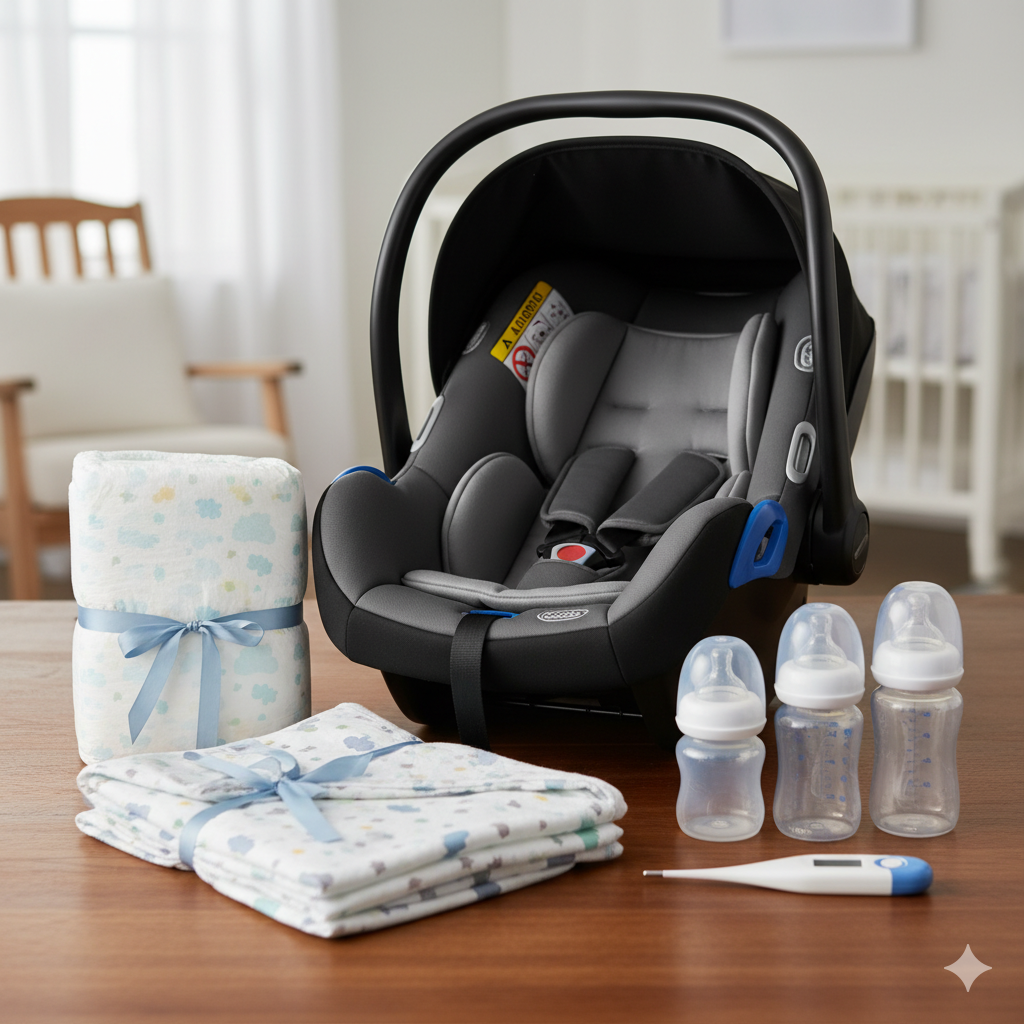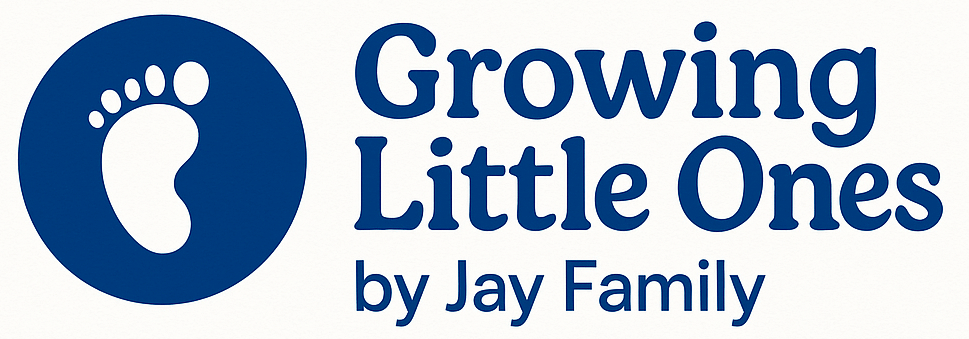
Welcoming a newborn is joyful and overwhelming. This Newborn Essentials guide gives a clear, evidence-based checklist—what to buy, safe sleep, feeding basics, diapering, travel and safety—so you can prepare with confidence.
Preparing the nursery & gear (newborn checklist)
Focus on safety, comfort and daily use. You don’t need every product marketed to new parents—prioritize AAP-recommended safe sleep and secure furniture.
- Safe sleep surface: crib or bassinet with firm mattress and fitted sheets (no soft bedding). See AAP safe sleep recommendations: AAP Safe Sleep.
- Changing station: sturdy dresser or changing table with safety strap and diapers within reach.
- Clothing basics: 5–8 bodysuits, 5–7 sleepers, hats, socks, swaddles or sleep sacks for temperature layering.
- Linens: 4–6 fitted crib sheets, a waterproof mattress cover.
- Baby monitor: audio or video monitor for peace of mind; follow privacy best practices.
- Nightlight and diaper caddy for quick nighttime care.
Setup tips:
- Place the crib away from windows, cords and blind strings to reduce hazards.
- Assemble furniture early; secure straps and keep small parts away from children.
- Keep a few ready-to-wear outfit changes and label storage bins for quick access.
Feeding essentials: breastfeeding and bottle feeding (baby feeding supplies)
Feeding is central in early weeks. Gather supplies and identify support (pediatrician, lactation consultant) ahead of time.
- Breastfeeding: comfortable nursing bra, breast pump if needed, nipple cream, nursing pads. Hospitals and clinics can refer an IBCLC for early support.
- Bottle-feeding: 4–6 newborn bottles, slow-flow nipples, bottle brush, and sterilizing options (boiling, steam or dishwasher sanitize cycle).
- Formula preparation: follow CDC safe-prep guidance: CDC Infant Formula Guidance.
- Comfort: a supportive chair, burp cloths and waterproof pads for nighttime feedings.
Feeding tips:
- Feed on demand—newborns often feed 8–12 times in 24 hours.
- Look for hunger cues (rooting, hand-to-mouth) instead of waiting for crying.
- WHO and UNICEF encourage skin-to-skin and early initiation when possible: WHO Breastfeeding.
Safe sleep, swaddling & sleep environment (newborn sleep safety)
Safe sleep practices lower SIDS risk. The AAP recommends placing babies on their backs on a separate sleep surface in the parents’ room for at least 6 months.
- Use a crib or bassinet that meets current safety standards; firm mattress and fitted sheet only.
- Avoid loose blankets, pillows, bumper pads and stuffed animals in the sleep area; use a sleep sack or wearable blanket instead.
- Room-sharing (same room, separate surface) is recommended for at least 6 months.
- Maintain a comfortable room temperature (about 68–72°F / 20–22°C) and dress baby in layers to avoid overheating.
- Swaddle safely and stop swaddling once baby shows signs of rolling; transition to a sleep sack when appropriate.
Resources and evidence:
- Find guidance from the CDC and AAP: CDC SIDS & Safe Sleep and AAP Safe Sleep.
- Contact your pediatrician for individualized advice if your baby has medical needs.
Diapering, bathing & basic newborn care (diapering supplies & hygiene)
Daily routines—diapering, cord care, bathing and first aid—are part of newborn care. Keep a simple kit ready and learn safe handling.
- Diapers: newborn and size 1. Expect 8–12 changes/day—start with 40–60 newborn diapers and adjust as needed.
- Wipes & washcloths: fragrance-free wipes or warm water and a soft cloth for sensitive skin.
- Diaper cream for occasional redness; consult your pediatrician for persistent rash.
- Bathing: baby tub or clean sink, mild baby wash, soft towel. Newborns need sponge baths until the umbilical cord falls off.
- Health kit: digital thermometer, nasal bulb, baby-safe nail clippers, and a small first-aid kit.
Care tips:
- Never leave a baby unattended on a changing surface; keep one hand on your baby.
- Keep the umbilical stump clean and dry; contact your pediatrician for signs of infection (redness, foul odor, heavy bleeding).
- Infants under 3 months with rectal temp ≥100.4°F (38°C) need prompt medical evaluation. See Mayo Clinic and NIH resources: Mayo Clinic – Fever in Babies and NIH – Infant Fever.
Travel, car seats & leaving the house safely (car seat safety & outings)
Bring your newborn home with a correctly installed rear-facing car seat and a plan for safe outings. Many hospitals require a properly installed seat at discharge.
- Car seat: use a rear-facing infant seat or a convertible seat rear-facing as long as possible. Check manufacturer limits and expiration dates.
- Installation: follow the car seat and vehicle manuals; have installation checked by a certified CPST at local inspections. See CDC and NHTSA checklists: CDC Child Passenger Safety.
- Strollers & carriers: choose options that support head/neck and fit your lifestyle; follow AAP guidance on safe use of carriers and infant products.
- Outing checklist: extra diapers, feeding supplies, clothing change, blanket, phone and a small first-aid kit.
Safety tips:
- Never leave a baby unattended in a vehicle; heatstroke can occur rapidly.
- Remove bulky coats before strapping baby into a car seat; cover with blankets over the straps if needed.
- Start with short outings while you learn feeding and sleep rhythms.
FAQs: common new parent questions
What are the absolute newborn essentials parents need right away?
Start with a rear-facing car seat (installed correctly), a firm crib or bassinet with fitted sheets, diapers and wipes, feeding supplies (breast or bottle), a thermometer, and a basic health kit. Keep skin-to-skin and postpartum supports in place. Trusted sources include the AAP and CDC.
How many diapers will I need for a newborn?
Expect about 8–12 diaper changes per day. Plan for 40–60 newborn diapers to start, then adjust as you learn your baby’s schedule. Babies often move to size 1 within a few weeks.
When should a car seat be installed and inspected?
Install the car seat before bringing baby home. Many hospitals require a correct installation for discharge. Have a certified Child Passenger Safety Technician (CPST) inspect the installation at a local station, fire department or hospital.
How do I know if my baby is feeding enough?
Signs of adequate feeding include 6+ wet diapers a day after the first days, steady weight gain and settled behavior after feeds. Your pediatrician will track weight; contact an IBCLC or pediatric team if you have feeding concerns.
What items can I skip to save money?
Skip single-use or novelty gadgets you’ll rarely use—specialty sleep positioners (unsafe), too many outfits, or nonessential baby tech. Invest in safety and repeat-use items: car seat, sleep surface, feeding supplies and diapers.
Conclusion: final checklist and next steps
Preparing for a newborn is about prioritizing safety, feeding basics and a calm sleep environment. Use this checklist to get the essentials ready: a correctly installed car seat, a firm sleep surface, feeding supplies, diapers and a simple health kit. Reach out to your pediatrician, lactation consultants and certified car seat technicians for support.
- Immediate: install car seat, set up crib/bassinet, prepare feeding area, stock diapers and thermometer.
- Within the first week: schedule pediatrician visit, arrange lactation support if breastfeeding, have car seat checked.
- Ongoing: adjust clothing and diapers as baby grows, follow safe sleep guidance, and contact professionals for medical or feeding concerns.
You don’t need to know everything at once. Use the lists, ask for help, and trust your instincts—your pediatrician and community resources are there to guide you.
